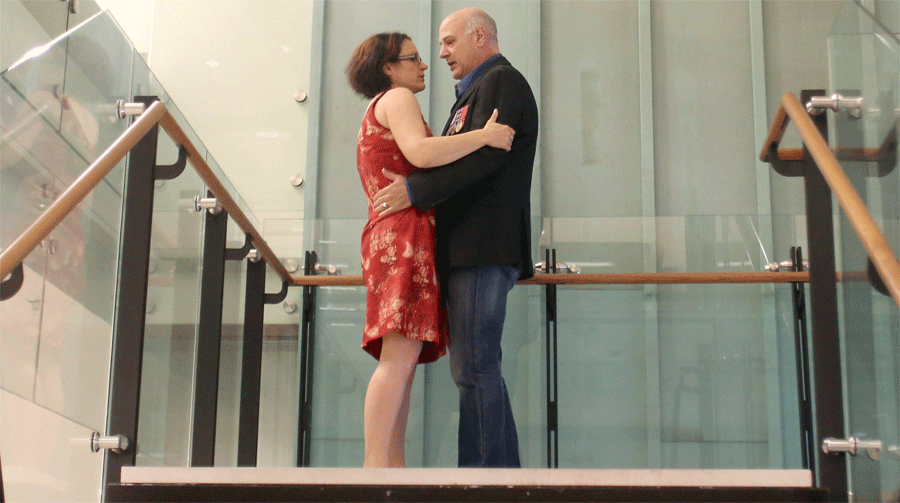
This piece originally appeared in Maisonneuve magazine.
Jenifer Migneault waited alone in a parking lot while teams of police searched for her missing husband. Claude Rainville had been gone for over an hour and Migneault had no idea who to call. Over the past 13 years, Rainville, a war veteran with the Canadian Armed Forces, had alienated most of their social circle and siblings with the same erratic behaviour that had caused him to go missing. Migneault’s only nearby relative was her 15-year-old son, working a shift at McDonald’s. She tried to suppress her panic in front of the police, but it kept spilling over into tears. Somebody pinch me. This nightmare has to end.
It was 5:30 p.m. Left on his own, Rainville began to change. He was no longer a man on a walk with his wife around a lake framed by flowers and trees.
He was a soldier back on the battlefield.
Rainville marched the bike trail through the forest. In the pitch black, he strayed from the path and slinked among the trees. The farmers in nearby houses were enemies out to attack him. His camera, memory card filled with nature shots, was a gun. He held it poised, ready to fire, and walked fast, occasionally breaking into sprints, just like he had been trained to do. His breathing was perfect. His back didn’t bother him at all. He travelled roughly 25 kilometres in six hours.
About halfway through his trip, Rainville snapped back to reality. He lay down on the cement under a highway overpass, looked up at the bridge, and thought about how easily he could end his life. The constant ringing in his ears from more than 5,000 hours spent on a military plane would stop. The pain he caused his family could be gone with one jump. But Rainville pictured his wife’s face, with her dimples and her infectious smile, and got back on his feet. Then he was lost again; returned to soldier-mode.
When Rainville didn’t meet her at the car, Migneault called the police, who arrived on the scene and peppered her with questions. Was her husband more likely to be in the woods or on the street? Did she last see him north or south of the parking lot? Migneault was terrible with directions but felt pressure to answer correctly. She worried she might be considered a suspect in his disappearance. Her voice became high-pitched and frenzied. One officer told her to get a grip. As it got darker, Migneault imagined worst-case scenarios: after a recent fight, she had found her husband in the bathtub holding a razor blade to his wrist. She prayed the police would find him alive.
Around midnight, Rainville showed up at the McDonald’s. The police called her right away. She pulled into the restaurant’s parking lot and noticed through the windshield that her husband was not himself. Despite the pressure on his back from six hours of non-stop activity, he stood tall between two policeman. For hours, she had worried Rainville was dead. Now, she found him alive and at war. She threw her arms around him and said “I’m so fucking happy to see you.” He gave her a limp pat on the back and said, distracted, “Hi, how are you?” He was looking above the heads of the policemen for enemies.
Once they arrived home, Rainville lay naked on his back in their bed. Migneault started to massage his exhausted legs. If they made love, she thought, surely her husband would reappear. But when they started having sex, Rainville treated her like a one-night stand. He didn’t kiss her. He didn’t pleasure her. After ten minutes, he came, then fell asleep. Migneault lay awake wondering how this stranger could share a body with the man she married. It would be roughly a week before Claude returned to himself.
For veterans’ spouses such as Migneault, post-traumatic stress disorder (PTSD) turns domestic life into a battlefield. According to the Canadian Mental Health Association, 10 per cent of war zone veterans suffer from PTSD, the mental illness triggered when someone experiences terror. Behind those veterans are families struggling to help their loved ones cope.
PTSD is all-consuming. Spouses must sacrifice their independence to care for wounded veterans. These spouses often lose their jobs, their social lives and their sanity, yet are virtually ignored by Veterans Affairs Canada (VAC). There is a profound lack of government support to help them become adequate caregivers and remain financially stable, let alone balance their own personal desires with a veteran’s erratic behaviour. Many suffer in isolation, their lives swallowed whole by PTSD.
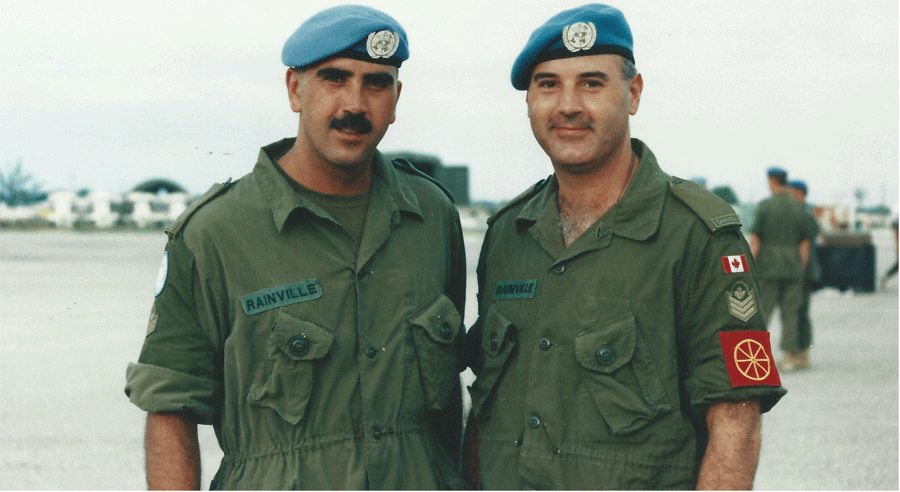
Rainville served for 20 years as a military traffic technician. He’s loaded and unloaded freight and troops from air-crafts in over seventy countries, including Kuwait, Rwanda and Syria. His last and longest stint with the Canadian Forces was seventeen months in Haiti in 1996 and 1997, on a United Nations mission. He remembers feeling “fucked up” by the end of it, tired of the relentless heat and the smell of rotting flesh.
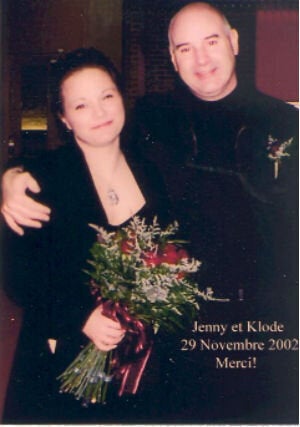
Migneault met Rainville in 2001, three years after he had left the military. They married the following year; both brought two children from previous relationships into their new family. It wasn’t long before Migneault noticed her new husband’s behaviour was changing. When he closed his eyes, Rainville was crashing in his plane or running from gunshots. He imagined a recurring image, which came to him often: a Muslim woman tied up naked and the hands of torturers who peeled off her skin inch by inch. Other horrific visions were real memories, such as the morgue in Haiti, where dead babies were piled on top of one another on shelves, their feet dangling like dolls in some dystopian toy store. Migneault would often wake up to find her husband on their bedroom floor, gasping for air.
Rainville suffered from severe tinnitus in both ears, loud enough that if you played the frequency on a speaker, you could hear it through two walls; it was a constant reminder of the horrors he had witnessed. He was hyper-vigilant and preferred to stay inside with the blinds drawn. A loud noise would make him jump or run. He often lost his temper. To block out the flashbacks, Rainville drank. Addiction is a common symptom of PTSD, and he regularly closed himself in the bedroom with a few bottles of red wine
Chris Dupee had been isolating himself from his wife and children since he returned from Afghanistan in 2009, but when he was diagnosed with PTSD in 2010, his wife Angel Dupee was oblivious to the implications. “I had never heard that phrase ever before he came home,” she says. “Nobody warned us there was a chance this could happen.” Chris was on a heavy dose of sleeping pills to calm his night terrors. She remembers a horrific morning in 2013, when she had a miscarriage the doctors had told her was coming. Chris was almost impossible to wake, asleep until she started to hemorrhage and he came, groggy, to her aid. “It seemed to me that he was numb to it,” she said. Afterwards, he never spoke of the incident. “It was as if it never happened.”
Chris Dupee and Rainville have many of the hallmarks of PTSD sufferers, which can include nightmares, flashbacks, hyper-vigilance, panic attacks, sadness, anger, dissociation, isolation, emotional detachment, memory loss, chronic fatigue, marital problems, substance abuse and self-medication. Some leave combat behind while others are plagued with traumatic memories. The standard treatment for a soldier or veteran diagnosed with PTSD is a combination of psychotherapy and medication. If the disorder is left untreated long enough, it can become chronic and major depression can develop, Dr. Stéphane Guay, the director of the Trauma Study Centre at Montreal’s Louis-H. Lafontaine Hospital, said in a 2007 parliamentary session. “When [soldiers] are six to seven months in the field, they’ve learned to live a very rigid kind of life,” says Dr. Ron Warner, a psychologist who specializes in stress and trauma and worked as a contract psychologist at Canadian Forces Base Kingston in Ontario. Acclimating to the unpredictability of children, spouses and a civilian existence can be extremely challenging.
Warner often suggests that his patients bring their partners to therapy sessions, which is not mainstream practice. “When you have a veteran traumatized, you probably have a wife traumatized as well,” he says. Veterans’ spouses can suffer from secondary traumatic stress (STS), a condition where a caregiver shows PTSD-like symptoms. According to a study from the University of Rijeka in Croatia, almost 95 per cent of spouses living with PTSD-wracked veterans took on at least one of their symptoms. One-third of participants qualified as having STS.
Many spouses caring for veterans with PTSD reach a mental or physical breaking point, especially when they have no support network or life outside the home. “If someone is acutely suicidal ... [or if] you can’t predict what mood somebody’s going to be in from one minute to another, I think the caregiver constantly can be found on guard wondering what’s going to happen next,” says Dr. Ruth Lanius, the director of the PTSD research unit at Western University in London, Ontario. Dr. Lanius always encourages her patients to lean on professional caregivers before family members. Without external support, she says juggling a career and caring for someone with severe PTSD is “impossible.”
Virginia Shaw is a 44-year-old from Pictou County, Nova Scotia. At night, the trauma of picking up body parts after the Swissair crash near Peggy’s Cove in 1998 would envelop her husband, Shane Porter. The veteran would set off the smoke detector so he could evacuate Shaw, her nine-year-old daughter and their two-year-old daughter onto the street. He was paranoid, and installed a $1,700 security system with cameras that captured every angle of the house. He stopped socializing and easily lost his temper. One night in 2011, Shaw noticed four of the pills Porter took to treat his PTSD floating in the toilet. When she confronted her husband in the kitchen, he picked up a hot pan with fried hamburger from the stove and threw it at her. He missed, but pieces of meat and grease splattered her legs and arms. “I felt like a prisoner of war in my own home,” she says. After 16 years of living with Porter’s PTSD, Shaw began to show symptoms of his trauma. “I felt suicidal.” She has recently been diagnosed with severe clinical depression, anxiety and social disorder.
Shaw, like Dupee and Migneault, had no idea what PTSD entailed. “We weren’t given any pamphlets or literature or anything,” she says. “I thought he had depression.” Porter’s PTSD paperwork was lost after his initial assessment and it was five years before a case manager checked up on the family. He only started to see a psychologist in 2011—twelve years after his diagnosis. But by that point, Porter was too far gone. He had already been charged and served 30days for possessing child pornography. In 2013, Porter assaulted Shaw and was put on a stay-away order. In July 2014, he hung himself.

Jenifer Migneault (right) and Marie-Andre Mallette, both spouses of military veterans, hold a news
conference on Parliament Hill in Ottawa, Thursday June 5, 2014. (Photo: Fred Chartrand/CP)
Jenifer Migneault is 42.
She wears two gold chains around her neck, one with Rainville’s pendant of airforce wings, and faux-diamond-studded flowers on her manicured fingernails. Her mother is an alcoholic whose then-boyfriend sexually assaulted Migneault for seven years when she was growing up. At 16, she fled from her hometown of Hull to escape the abuse. In an interview for her first real job, the manager asked Migneault her current salary. She was unemployed, so she said $30,000. He offered her $32,000. She went on to work as an employment consultant and in social and rural development. When her dyslexic son was failing out of Grade 2, Migneault home-schooled him for a year so that he could re-join the public system in grade three.
When Migneault first met Rainville, neither of them knew he suffered from PTSD. He had been released from the military in perfect health. Migneault loved his stories about serving overseas. He loved that she would listen. So many people were unable to.
Migneault has come up with a name to describe her husband’s military alter ego, the man he becomes when he dissociates and feels like he’s back in a combat zone: Rambo. Rainville became Rambo anytime he felt attacked in arguments. He saw Migneault as an enemy and lost all sympathy for her feelings. When she cried, he felt numb, a useful skill on the battlefield but not so much in your living room.
It became easier for Migneault to end her social life than to constantly justify her husband’s erratic behaviour. She stopped calling friends. She didn’t go out at night. She did all the cooking and cleaning; it was a good day if her husband had the energy to wipe down a kitchen counter or change out of his pajamas. The couple played online games for fourteen hours a day, smoking cigarettes and the pot Rainville used to treat his tinnitus. He could still be incredibly sweet and passionate. They made love often and were indulgent, eating oysters in bed or binge-watching movies. In those moments, Migneault was reminded of the man she had fallen in love with. But it did not take much for that man to become Rambo.
In 2004, the couple’s four kids were all living under their new roof in Farnham, Quebec. Migneault and Rainville fought constantly. When Rainville became emotionally detached, Migneault took it personally. When the couple had screaming matches, Migneault would pack a suitcase. By 2007 her own mental health was so bad that she took a sick leave from her new job working for the province. In 2008, she quit.
Rainville, meanwhile, cycled through 15 jobs in less than 10 years. He collapsed four times from anxiety attacks and ended up in the hospital. But he had to work: since he was released in perfect health, his pension only left $12,000 each year after he paid child support for his two teenage children, who eventually moved out, unable to deal with their father’s erratic behaviour.
In desperation, Rainville tried to return to the military in 2006, but the Department of National Defence told him that he was ineligible. His military medical file showed that he had suffered from severe depression upon release—a fact nobody ever told him.
Rainville never thought to call Veterans Affairs Canada for help with mental health issues. In his mind, the department was only there for a “guy who lost a leg or an arm.” But Rainville’s brother, who is also a veteran, mentioned that VAC might cover treatment for his fractured spine and give him a better pension. Rainville called VAC’s general information line in 2007. Migneault opened the door just as her husband reached someone at the department. Rainville held the phone in his right hand and his forehead in his left. He cried into the receiver. “I need help, madame. You have to understand I need help.” Migneault closed the door to give him privacy. She had never seen Rambo look so desperate.
A case manager called Rainville back the next day. She sent him paperwork so he could apply to be assessed for his physical and mental health problems. Rainville was overwhelmed. Migneault filled out the stack of forms. In July, Rainville was finally diagnosed with PTSD.
Despite filling out all the applications for Rainville’s health problems—forms between 10 and 20 pages, which according to the auditor general, take on average four months to assemble—Migneault was never contacted by his case managers, the people who help Rainville navigate VAC, or his psychologist and psychiatrist. “All communications [between] spouses and family caregivers are through the veteran and that might be a mistake,” says Veterans Ombudsman Guy Parent. “The fact [is] that sometimes [veterans with PTSD] are too proud [to declare] all the impacts the injury has on their daily life.” Even though VAC had set Rainville up with a psychologist and psychiatrist, he wasn’t improving. Rainville thought his psychologist was “part of the system [and] there to fuck me up.” He didn’t tell his therapist the truth, such as the fact that he was smoking pot to manage his tinnitus.

the government to reconsider its decision to close Veterans Affairs district offices in eight communities. (Photo: Sean Kilpatrick/CP)
Veterans Affairs Canada was a black eye on parliament. In January 2014, VAC announced that it would close eight regional offices in small towns and cities. When a group of veterans arranged a meeting with then-Veterans Affairs Minister Julian Fantino to protest the closures, he was 70 minutes late. VAC paid managers handsome bonuses while the department cut costs and shed jobs. A scathing report was released by the auditor general while Minister Fantino was in Italy to commemorate World War II. The report detailed how some veterans wait eight months to be approved for mental health benefits. Days before the report, the government announced it would spend $200 million on veterans’ mental health issues, but less than a week later, journalists reported that the money would be paid out over 50 years. (Not surprisingly, Minister Fantino was shuffled from the department in early January 2015.)
When veterans are abused by the system, they make national headlines. Spouses are invisible. “There’s a tendency to focus the public’s attention and political and institutional attention on the veterans themselves,” says Murray Brewster, a Canadian Press journalist who’s been covering the military since 1996. “But in the shadows and darkness behind is family that has to pick up the pieces.” VAC does not recognize that many family caregivers are unable to work and are not adequately compensated or supported by the government for their efforts. In March, it proposed a yearly benefit of $7,238 to provide them with “relief,” pocket change for someone who has quit work to care for a veteran. The department currently has no program to prepare them for the challenges of living with someone suffering from PTSD and it offers few benefits and services to help them manage tumultuous home lives. Guy Parent says that VAC was used to what he calls the old family model of one income-earning spouse and one caregiver. “The fact that a caregiver who’s a family member should not be compensated, that might have been okay 50 years ago, but that doesn’t work anymore,” he said in October. “I think it’s a failure to develop with the times.”
VAC insists it is adapting. “We are continuously looking at new ways in which we can provide the support that spouses now require, particularly when dealing with serious mental illnesses such as PTSD and other operational stress injuries,” says Anne-Marie Pellerin, the director of case management and support services for VAC. There is a 1-800 number spouses can call in case of emergencies and a link to a peer support group, Operational Stress Injury Social Support (OSISS). Migneault says she left a message for OSISS, but nobody ever returned her call. In some cases, depending on the nature of the veteran’s benefits plan, spouses are eligible for counselling sessions or employment programs. But it was five years after Rainville’s diagnosis before anyone told Migneault she was entitled to see a psychologist.
Linda Magill is a veteran and a vet’s spouse who fought VAC for over a year when the department took away her husband’s personal care allowance without notice. The benefit gave her $3,000 to pay someone to stay with Eric when she travels for her work as an occupational health and safety consultant. Eric mostly has to stay in bed; in addition to PTSD, he has had over 200 knee and leg operations due to his reactive arthritis. In the end, the benefit was re-instated, but Magill’s battle was hard-fought. “VAC brought me to my knees,” says the 61-one-year-old who has a double major undergraduate degree in psychology and law and justice, a college certification in business administration and a certification in occupational health and safety. “Now what the heck is a young corporal’s wife who has never worked anywhere but 7-Eleven and Mac’s milk [supposed to do]? How is she going to write an eleven-page appeal like I did?”
Magill, Migneault and spouses like them may have fared better in the United States, where Veterans Affairs (VA) offers caregiver support coordinators, similar to case managers, who help navigate the system’s benefits. There is an entire section on the VA website dedicated to spouses that includes information about home care services and respite care. There is even an American non-profit called Tragedy Assistance Program for Survivors that trains spouses to handle military grief. A 2009 internal report of the Canadian department pointed out that “family members are not entitled to direct support from VAC initially as a matter-of-right,” and called for that to change. Yet, five years later, the ombudsman’s 2014 report noted that nothing had.
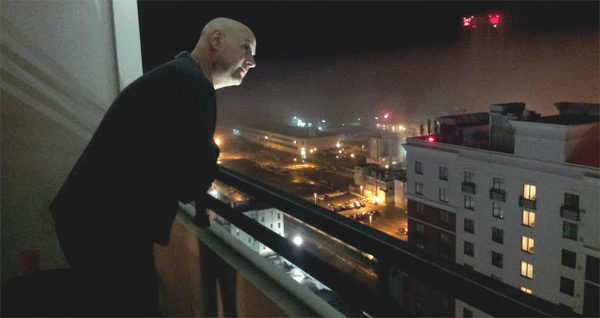
Claude Rainville in Atlantic City, January 2014 (Photo: Jenifer Migneault)
Nothing much had changed for Rainville, either. On a trip to Atlantic City in January 2014, he stood on his hotel balcony, 22 floors up, and told Migneault that he wanted to jump. The couple was getting desperate. In March, Migneault spoke at a press conference on Parliament Hill, advocating for VAC to support care-giving spouses. The pair began to attend VAC committee meetings regularly.
In May, Migneault stood outside of a parliamentary meeting room in Ottawa, trying to process what she had just heard from Minister Fantino. Utter bullshit. Fantino had addressed the ten-person Veterans Affairs Committee and a room full of journalists, veterans and parliament staffers. The door was surrounded by a throng of camera-people and reporters. Fantino mumbled his way through an explanation of VAC’s decision to increase its advertising budget by $4 million. He talked about funding a study to determine the importance of service dogs to veterans. They can train dogs but they aren’t going to train wives? Bullshit.
Migneault waited beside the door for the minister to come through, her anger spiralling. Rainville stood beside her. As Fantino made his way through the exit, the narrow hallway was filled with a flurry of flashing lights and pushy hands wielding microphones. As Migneault watched the scene unfold, she thought of her father, who had recently died of lung cancer. He had taught his daughter to always fight for herself. The minister passed her. “Mr. Fantino, can I talk to you please, as a spouse?” Her voice was almost completely masked by the press scrum. Fantino became so flustered that he mistook a closet door for an exit. But Migneault wasn’t finished. In a kind of trance, she said to Rainville, “I have to talk to him. I have to talk to him. I have to talk to him.” Rainville put his hand on Migneault’s lower back and gave her a nudge. “Go.”
Fantino was now in the building’s foyer and Migneault could barely see his head over the swarm of journalists. She pushed her way through and started to yell. “Mr. Fantino, as a spouse, can I talk to you please?” He turned left into another hallway that led to an exit. She chased after him, her high heels clacking on the tile floors. This time, Migneault spoke even louder. “Mr. Fantino,” she repeated, her voice echoing in the big atrium. “I’m just a vet’s spouse.” He did not turn back. Nor did any of his staff members. The minister disappeared through a door.
Migneault paused. “You’re forgetting us, once more,” she said, while journalists bunched up behind her like a tangled slinky. Her mind raced. Would security stop her if she walked further? Screw it. This one’s for you, Dad. She started down the now-empty hallway.
“We’re nothing to you,” Migneault said. She slowed down and shouted, “We’re just what? Nothing?” She pivoted to face the gathered journalists and took big strides back towards her audience.
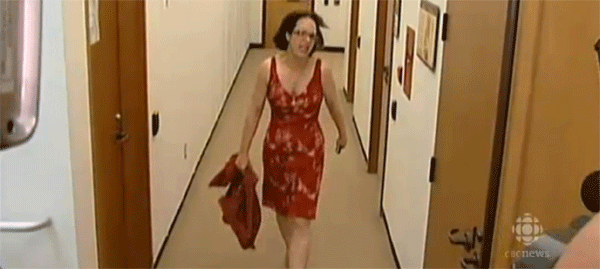
Julian Fantino, down a parliamentary hallway on May 29 (Photo: CBC)
“Nothing. This is what we are,” she said, enunciating clearly in her sharp French accent, as if taking vicious bites out of the air. “Nothing. Again.” She delivered one last knockout: “You’re going to hear from us. The spouses.”
A scrum formed around her. “What were you hoping to speak with the minister about?” asked a CTV reporter. “What about when you hear they are spending $4 million more on advertising?” asked Brewster. As she answered questions, Migneault worried about Rainville. Where was he? After six minutes she found him sitting on the landing of a staircase, crying. She rushed over.
“Take me out of here,” he said.
She held his arms and looked directly into his eyes. “Just breathe.”
The journalists had started to snap pictures. She led her husband to the upstairs cafeteria where they could drink coffee in peace. For the rest of the day, Migneault and Rainville didn’t think about the incident. They walked around a park in Hull and ate dinner with another veteran and his wife. When they drove home from Ottawa around 7 p.m., they still hadn’t checked the news.
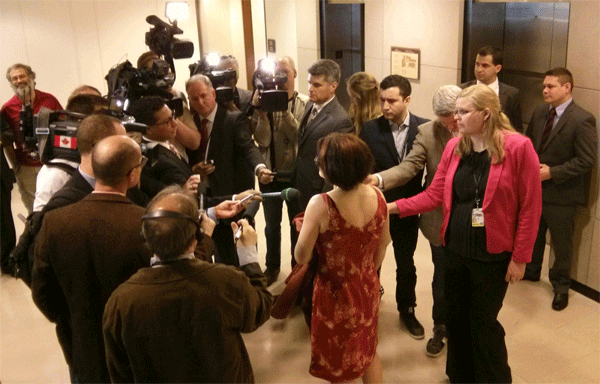
(Photo: Jerry Kovacs/Canadian Veterans Advocacy)
At 9:30 the next morning, Migneault’s phone rang. A journalist from CTV wanted to interview her in their Montreal studio, a 45-minute drive from their house in Farnham. As Rainville drove, more media requests rolled in. After her fourth TV appearance that morning, Migneault decided she wanted to wear a new shirt for her next two spots. She took $20 from the $125 she had earned from CBC earlier that day, went to Simons department store and bought a new t-shirt with her own money. A first in seven years.
Migneault made her pitch over and over: train spouses as caregivers. Support us so we can support your heroes. There was a subtext to her plea: help me be my own person in addition to being a vet’s spouse.
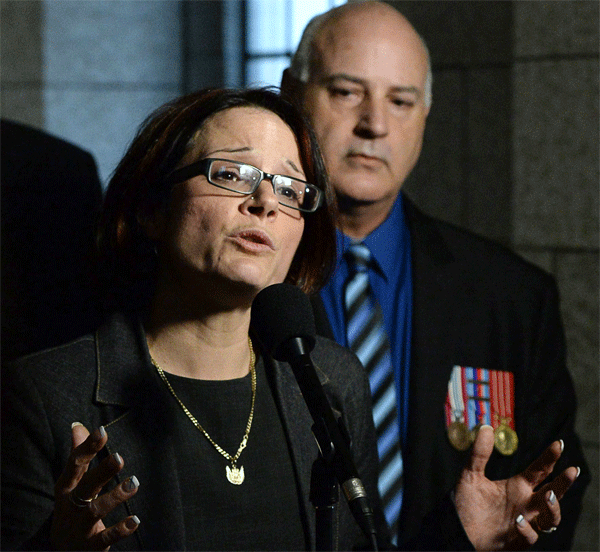
regarding the issues of caregivers helping veterans with PTSD. Her husband and veteran
Claude Rainville stands at her side. (Photo: Sean Kilpatrick/The Canadian Press)
In the next month, she met with Justice Minister Peter MacKay, staff members from the Department of National Defence, Veterans Affairs Canada and the entire NDP caucus to promote her cause. When she spoke, people listened—Migneault can make a recipe sound like a presidential address. She’s a verbal boxer whose words land fast and sharp. She hits you with repetition—bang! bang!—and then pauses for a few seconds before she delivers a KO. But her greatest strength is her honesty. When Migneault meets with politicians, she never prepares notes or briefs herself on policy. She is all story and heart. The day after she confronted Fantino, she told CBC Radio, “When my husband has dreams of being killed or killing someone, tell me how to wake him up. Because do you know how many times I was punched?”
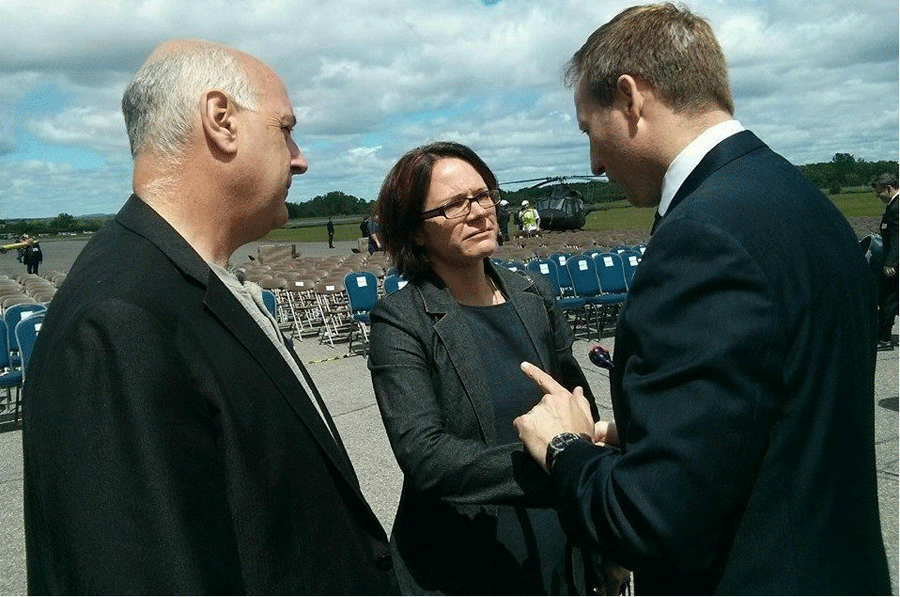
In June, the Veterans Affairs Committee, a mix of 10 Conservative, Liberal and NDP members of parliament, recommended that spouses of veterans with PTSD should be able to access counselling without going through the veteran. They also suggested that spouses who act as primary caregivers should be compensated.
After hearing her speak in August at a roundtable in Ottawa, a veteran in the audience started to cry. While another panelist spoke, Migneault walked into the middle of the crowd and gave him a long hug. These were the moments she lived for. If she reached one person, she felt she had done her job.
As Migneault became more high-profile, other spouses contacted her. She assembled eleven of these women into a group called the Red Flaggers, to help advocate for caregivers in every province. Her organization spawned another round of media interviews. She made good on her promise to Fantino that he would hear from her again. When she finally sat down with the then-minister and his chief-of-staff in September 2014, Migneault introduced herself as the president and founder of the Red Flaggers.
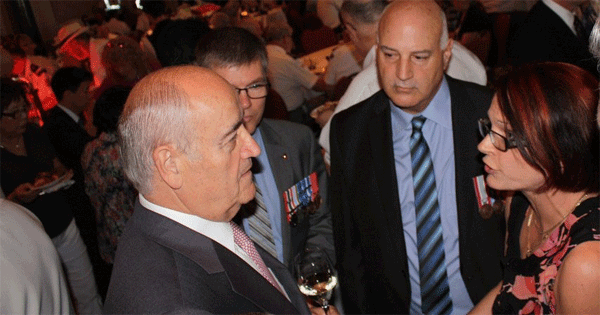
War Commemoration event June 29. They had a proper meeting in September 2014
(Photo: Sylvain Chartrand/Canadian Veterans Advocacy)
In October 2014, Fantino announced intended changes to the New Veterans Charter, the document that specifies the department’s programs and benefits. The department promised “access to a suite of services, including a new program to train caregivers to cope with severely injured family members,” Brewster wrote in a Canadian Press story. The program, which will be available in spring 2015, is an online resource to help families and caregivers manage mental illnesses such as PTSD. At the end of November, the government announced a pilot project that gives certain veterans and their families access to a network of services that were previously only available to still-serving members, such as child care and counselling.
Since Fantino’s fractious meeting with veterans, the opposition had been calling for his dismissal. “Will the prime minister do the right thing—apologize himself and fire that incompetent?” asked Tom Mulcair in a January 2014 question period. After the auditor general’s report was released, the Liberal party created online ads with tag lines such as: “Veterans fought for us. They shouldn’t have to fight their own government.” In January 2015, Fantino was demoted to his former position as associate minister of National Defence. In the press, his encounter with Migneault was cited as one of the events that contributed to his downfall. In March, when the new Veterans Affairs Minister, Erin O’Toole, announced a proposed yearly family caregiver benefit of just over $7,000, the media referenced Migneault’s famous chase after Fantino. The day of both announcements, her schedule was full of interviews. Journalists wanted to know if she finally felt validated.

She appeared alongside high-profile guests such as Roméo Dallaire and Public Safety Minister
Steven Blaney. (Photo: Claude Rainville)
Migneault felt like the Fantino incident resuscitated a part of her personality that Rainville’s PTSD had smothered. For over a decade, Migneault’s entire schedule had revolved around his mental health. If Rainville’s mood changed, they cancelled their plans. If he panicked in public, they went home. If he woke up in the night, she did too.
Now, Migneault had a schedule of her own filled with appointments, phone calls and travel. She and Rainville spent most of the summer of 2014 travelling in Ontario and the Maritimes to network. They constantly shuffled between Ottawa and Quebec. Rainville would doze in the car while Migneault hustled in the House of Commons. The people she was meeting became more prominent: retired Lieutenant-General Roméo Dallaire, Member of Parliament Marc Garneau, Liberal Party Leader Justin Trudeau.
Thanks in part to Migneault, spouses would now have more support, but she had never benefitted from the resources she was fighting for. As a result, she hadn’t learned to balance her political goals with Rainville’s needs. A caregiver program would have given her the tools to manage PTSD and her career. She would have known how to predict and minimize triggers so they didn’t always fight. She could have explained his behaviour to family and friends instead of retreating from the world.
Rainville was supportive of Migneault’s advocacy, but he couldn’t keep up with their new schedule. He found the trips to Ottawa exhausting. Before the couple met Dallaire—one of her husband’s heroes—Rainville fell asleep in an underground parking lot with no reception. He arrived fifteen minutes late to meet the retired lieutenant-general.
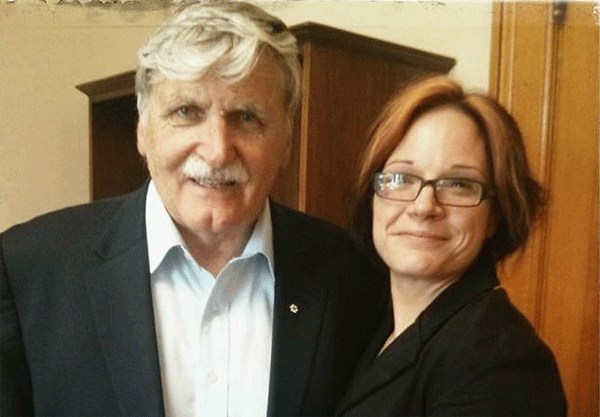
Jenifer Migneault meets with retired Lieutenant-General Roméo Dallaire on August 14, 2014. (Photo: Claude Rainville)
As Migneault’s profile became more public, Rainville’s paranoia grew. He was convinced the government was watching them. He set up a Google alert for Migneault’s name and became angry if she didn’t tell him about every email she received or meeting she had booked. He refused to go outside. He would not grocery shop or run errands and constantly delayed tasks he had promised to do around the house. He spent hours gambling online—while she pitched to politicians, he prayed for the right poker cards. “I don’t want to spend the rest of my life sitting in front of a computer beside a husband,” she told him one night. Rainville replied that while she had a cause to focus on, he had nothing.
A month after the VAC committee meeting with Fantino, Rainville and Migneault started to say the “d” word. One night in late July 2014 they stayed at a vet’s spouse’s house in Trenton, Ontario, at the end of a networking trip. Migneault had heard rumours that she might be asked to run for the NDP. Rainville asked her to promise that if her career took off, she would stay faithful to him. Migneault responded that she didn’t know if she could balance a work schedule and their marriage. Their marital issues were a classic symptom of caregiver burnout.
Migneault started to leave him out of plans, because networking was easier without his unpredictable moods. She dreamed of raising $10,000 so she could buy an RV and travel around Canada to meet with more spouses, organizations and politicians, but she also felt a profound sense of guilt. On trips, Rainville, reminded of his limitations, would announce that he wouldn’t hold Migneault back anymore. They would cry and scream. Neither of them wanted to be apart, but neither of them thought Migneault could have a career and be a caregiver. There was no family support to fall back on—Rainville and his two children no longer speak in person. Though his 26-year-old son lives in the same town, he didn’t acknowledge his father when they last ran into each other. He last heard from his 28-year-old daughter, who lives 40 minutes away, when she sent him a birthday message on Facebook in June. She had a child in December 2013 whom Rainville isn’t sure he will ever meet.
During their talk of divorce, Migneault never knew whether Rainville or Rambo would show up. Rainville articulated all the regular feelings associated with potential heartbreak, but Rambo would cut through emotion with his decisiveness. Love was like any other battlefield, where tough choices were made with the head instead of the heart. Rainville wanted to work out their problems. Rambo wanted to sever their relationship and move on.
One morning in September 2014, Rambo decided he wanted a divorce. He had arrived at the same decision before, but this time, it felt final. He read and re-read a Facebook post Migneault wrote days earlier about how the Fantino event had changed her life. Rambo concluded he had no place in her new world. Full stop.
In the computer room, they fought and smoked for about an hour. Migneault did most of the talking. She wanted to try to save their marriage. She reminded her husband that they had their first couple’s therapy session scheduled for the following week. She begged him to show some will. But Rambo just looked at her with a sarcastic smile. Relationships couldn’t be fixed. “Once you have a broken leg it’s always broken,” he said. They didn’t speak for the rest of the day.
Around 7 p.m., Migneault made plans to meet one of her few friends, Chantal Paris, for a walk. She smoked a joint, put on an oversized hoodie and left the house. They met on a path that coils around the Yamaska River. As the lighted fountain on the water shot bursts of red, yellow and orange into the air, Migneault crumpled over Paris’ shoulder. For the first time all day, she let herself process what Rambo’s decision meant. “How can I continue the way that I’m doing right now?” she asked. “I have to find a job. How will I be able to work, Chantal?”
Paris said all the right things. She told Migneault it was for the best—that this cycle with Rainville and Rambo would never stop. She offered her a place to stay. Migneault said she would have to step down as president of the Red Flaggers so as not to seem like a hypocrite. How could she be an advocate for caregivers if she no longer was one? She would either be touted as an example of how the system fails spouses or condemned as a selfish, disloyal traitor. Paris told her to slow down.
By the end of their almost hour-long walk, Migneault had formulated a plan. She would move in with her mother in Hull. After crying so much, Migneault reached that delirious stage where she saw the silver lining to an awful situation. “I’ll become who I want to become,” she said, her eyes filling with tears. But those plans were unnecessary. The PTSD-fuelled cycle was coming full circle. When she returned home, Rainville had shed his invisible uniform. He calmly told his wife he didn’t want to throw away 13 years of marriage. He would try couple’s therapy. He would try to be less jealous. After all, they were a team. Migneault shrugged off Rambo’s words like a bad dream.
The next morning, around 9:30 a.m., Migneault listened while Rainville spoke to his case manager on the phone. More delays on a masking device that could help his tinnitus. More paperwork. More bullshit. She smoked a cigarette and tears welled up in her eyes. How much longer would her hero have to suffer? How much longer would their relationship have to suffer as a result?
When Migneault’s out in the world, she feels like a new person. When she sits across from politicians and stands behind podiums, she’s reminded of how far she’s come from years spent secluded in the computer room. But when she gets home, nothing has changed. The calls with VAC. Her husband’s pain. Their isolation. And she would soon lose another pillar of support: the Red Flaggers, uncomfortable with Migneault’s determined tactics and emotional message, disbanded in September 2014. Every day when she kicks off her shoes and puts down the grocery bags, she continues her 13-year-long battle with PTSD. In her domestic war zone, Migneault is not a winner. She’s just a vet’s spouse.
This piece originally appeared in Maisonneuve magazine.
UPDATE: Since this piece originally appeared in Maisonneuve, Veterans Affairs Canada announced a proposed family caregiver relief benefit of $7,238 a year.
Angelina Chapin is the senior blogs editor at Huffington Post Canada
